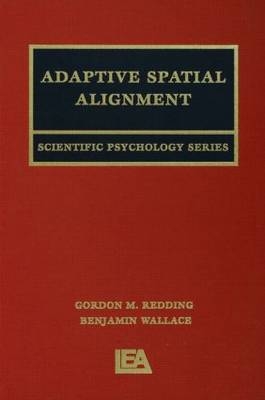
Adaptive Spatial Alignment
Seiten
1997
Lawrence Erlbaum Associates Inc (Verlag)
978-0-8058-2395-0 (ISBN)
Lawrence Erlbaum Associates Inc (Verlag)
978-0-8058-2395-0 (ISBN)
- Titel ist leider vergriffen;
keine Neuauflage - Artikel merken
This monograph relates prism adaptation to the larger context of cognitive science, especially motor control and learning. The first part sketches the background on its contribution to the issue of adaptive perceptual-motor performance, whilst the second outlines methodology and theory.
For most people, prism adaptation is an amusing demonstration, first experienced perhaps in an introductory psychology course. This monograph relates this peculiar phenomenon to the larger context of cognitive science, especially motor control and learning. The first part sketches the background concepts necessary to understand the contribution of prism adaptation to the larger issue of adaptive perceptual-motor performance including:
* a review of the basic concepts of motor control and learning that enable strategic response in the prism adaptation situation;
* the development of a hypothesis about spatial representation and spatial mapping and an introduction to the basic idea of adaptive spatial alignment; and
* a contrasting view of perceptual and motor learning and a review of evidence for the involvement of nonassociative and associative learning in prism adaptation.
Directly concerned with data and theory in prism adaptation, the second part presents:
* an outline of prism adaptation methodology and a list of several empirical conclusions from previous research that constrained development of theoretical framework;
* a theory of strategic perceptual-motor control and learning which enables adaptive performance during prism exposure, but does not directly involve adaptive spatial alignment;
* an extention of the theory to include realignment processes which correct for the spatial misalignment among sensorimotor systems produced by prisms; and
* a demonstration of how traditional issues in prism adaptation may be rephrased in terms of the present theoretical framework.
The last part of this volume reviews the research conducted in developing and testing the present theory of prism adaptation. It summarizes the initial investigations (employing a naturalistic exposure setting), reports some more rigorous tests with an experimentally constrained research paradigm, points out the more general theoretical issues raised by the authors' analysis of prism adaptation, and makes specific suggestions for further research within the prism adaptation paradigm.
For most people, prism adaptation is an amusing demonstration, first experienced perhaps in an introductory psychology course. This monograph relates this peculiar phenomenon to the larger context of cognitive science, especially motor control and learning. The first part sketches the background concepts necessary to understand the contribution of prism adaptation to the larger issue of adaptive perceptual-motor performance including:
* a review of the basic concepts of motor control and learning that enable strategic response in the prism adaptation situation;
* the development of a hypothesis about spatial representation and spatial mapping and an introduction to the basic idea of adaptive spatial alignment; and
* a contrasting view of perceptual and motor learning and a review of evidence for the involvement of nonassociative and associative learning in prism adaptation.
Directly concerned with data and theory in prism adaptation, the second part presents:
* an outline of prism adaptation methodology and a list of several empirical conclusions from previous research that constrained development of theoretical framework;
* a theory of strategic perceptual-motor control and learning which enables adaptive performance during prism exposure, but does not directly involve adaptive spatial alignment;
* an extention of the theory to include realignment processes which correct for the spatial misalignment among sensorimotor systems produced by prisms; and
* a demonstration of how traditional issues in prism adaptation may be rephrased in terms of the present theoretical framework.
The last part of this volume reviews the research conducted in developing and testing the present theory of prism adaptation. It summarizes the initial investigations (employing a naturalistic exposure setting), reports some more rigorous tests with an experimentally constrained research paradigm, points out the more general theoretical issues raised by the authors' analysis of prism adaptation, and makes specific suggestions for further research within the prism adaptation paradigm.
Contents: Preface. Part I: Perceptual-Motor Performance. Strategic Perceptual-Motor Control. Sensorimotor Transformation. Perceptual-Motor Learning. Part II: Prism Adaptation. Paradigm and Generalizations. Contributions of Strategic Control. Alignment and Realignment. Theoretical Issues. Part III: Research. Adaptation During Locomotion. Adaptive Eye-Hand Coordination. Implications.
| Reihe/Serie | Scientific Psychology Series |
|---|---|
| Verlagsort | Mahwah |
| Sprache | englisch |
| Maße | 152 x 229 mm |
| Gewicht | 522 g |
| Themenwelt | Geisteswissenschaften ► Psychologie ► Allgemeine Psychologie |
| Naturwissenschaften ► Biologie ► Humanbiologie | |
| Naturwissenschaften ► Biologie ► Zoologie | |
| ISBN-10 | 0-8058-2395-6 / 0805823956 |
| ISBN-13 | 978-0-8058-2395-0 / 9780805823950 |
| Zustand | Neuware |
| Haben Sie eine Frage zum Produkt? |
Mehr entdecken
aus dem Bereich
aus dem Bereich
wie Affekte innere Entwicklung ermöglichen
Buch | Softcover (2023)
Klett-Cotta (Verlag)
CHF 41,95
Buch | Softcover (2024)
Hogrefe Verlag
CHF 46,50


